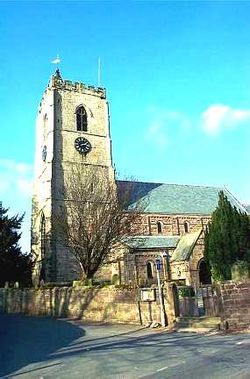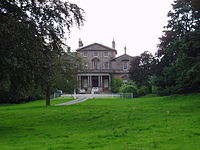Spofforth
| Spofforth | |
| Yorkshire West Riding | |
|---|---|
 All Saints' Church, Spofforth | |
| Location | |
| Grid reference: | SE364510 |
| Location: | 53°57’15"N, 1°26’47"W |
| Data | |
| Post town: | Harrogate |
| Postcode: | HG3 |
| Local Government | |
| Council: | North Yorkshire |
| Parliamentary constituency: |
Selby and Ainsty |
Spofforth is a village in the West Riding of Yorkshire, about three miles north-west of Wetherby and fivee miles south of Harrogate on the River Crimple, a tributary of the River Nidd.
History
Spofforth grew as a village at the time that Knaresborough was the important town in the area with Harrogate and Wetherby being less so. The village saw the building of the castle in the thirteenth century.
Eighteenth century Knaresborough road builder Blind Jack Metcalf spent the latter years of his life in the village and is buried in the church yard.
Stockeld Park, a Palladian villa was built in the 19th century. The railway came to Spofforth in 1847 with the building of the Harrogate to Church Fenton Line with Spofforth being the only intermediate station between Wetherby York Road station and Harrogate station. The line closed to passengers in 1964 and to goods in 1966 as part of the Beeching axe. Part of this forms the Harland Way cycle path which runs as far as Thorp Arch.
Church
All Saints' Church is the parish church of Spofforth and Kirk Deighton with Follifoot and Little Ribston. The date of the church's foundation is unknown and it is not mentioned in the Domesday Book. In 1893 a portion of an Anglo-Saxon cross was found built into the stairs of the tower. It is likely that an earlier church existed and was rebuilt between 1175 and 1200, with the doorway in the south porch dating from around this time. The first rector was Henry de Evesham inducted in 1280. Another was William de Melon (1310–1317) Treasurer of England and keeper of the great seal. The church tower was built in 1450. The earliest bell dates from between 1570 and 1593.
The church was restored "in an elegant and substantial manner" during 1854–5 under the supervision of the architect, Mr J W Hugall of Cheltenham. It was re-opened in September 1855 by the Lord Bishop of Ripon. There was criticism at the time of the "most ugly and objectionable pew" which occupied the south side of the church, and the fact that "the seats on the north are, consequently, incorrectly arranged".[1]
James Tripp (1847–1879) built the church and school at Follifoot and also built the schools at Linton and Spofforth.[2]
Spofforth Methodist Church, no longer in active use, is on School Lane.
About the village


The ruins of Spofforth Castle,[3][4] which date from the 13th century, are close to the centre of the village.
Stockeld Park, south of the village near Sicklinghall, is a stone-built 18th-century Palladian villa.[5]
The village has two pubs, the Castle and the Railway Inn. The Castle is the larger pub in the village and has a single open plan room. The Railway is a small pub with a traditional lounge and tap room configuration and was converted from two railway cottages. Two other pubs in the village did exist, the King William IV which closed in the early 2000s and the Prince of Wales in Castle Street closed in around 1927 and is now a private residence (Oulton House). The Prince of Wales served as the place where village inquests were held during the 1800s.
-
Former Prince of Wales Pub, Castle Street
-
The Castle
-
The Railway
-
On extreme right hand side - former site of William IV
Outside links
| ("Wikimedia Commons" has material about Spofforth) |
References
- ↑ "Leeds Intelligencer". Leeds Intelligencer. 22 September 1855.
- ↑ Spofforth Village
- ↑ "Spofforth Castle". http://www.castlexplorer.co.uk/england/spofforth/spofforth.php. Retrieved 26 January 2007.
- ↑ "Ukattraction.com". Ukattraction.com. http://www.ukattraction.com/yorkshire/spofforth-castle.htm. Retrieved 12 June 2016.
- ↑ "Stockeld Park an historic house in Wetherby, Yorkshire, to visit". tourUK.co.uk. 23 January 2014. http://www.touruk.co.uk/houses/houseyorkshire_stockeld.htm. Retrieved 12 June 2016.




